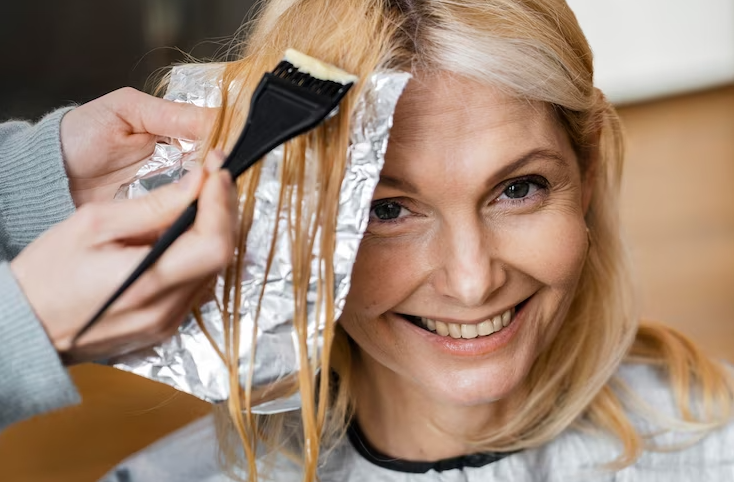Undoubtedly, hair plays a pivotal role in defining one's overall appearance. In light of this, individuals have become increasingly mindful of their hair and are exploring various avenues to achieve a distinctive look. This has led to the widespread adoption of hair dyeing as a means to enhance beauty and express individuality.
However, amidst the allure of colored locks, there exists a prevalent concern - hair fall. The act of dyeing hair, while transformative, often brings along the unwanted companion of hair fall. As hair coloring gains momentum, it's not uncommon for hair loss to become an integral part of the equation.

In the realm of challenges, solutions invariably emerge. By embracing vigilant care practices and heeding the guidance of experts, it's possible to rein in post-dye hair fall. This article explores a thorough list of ten easy techniques to successfully stop hair loss after coloring hair.
For those grappling with the distressing issue of hair loss, this is precisely where you need to be. Let us explore these methods in more detail; Not only will you find this exploration enlightening, but you will also learn useful methods for preventing hair loss brought on by the dyeing procedure.
read more How to Dye Curly Hair at Home without Damaging?
What triggers hair loss after the coloring procedure?
It's great to add color to your hair and enjoy a fresh look, but for some women, there's a concern – they observe their hair thinning after frequent coloring. What's the underlying reason?
The explanation revolves around the ingredients employed. Numerous hair dyes available for purchase contain harmful elements such as ammonia, PPD, or hydrogen peroxide. These compounds can erode the natural nutrients and proteins in your hair, causing it to gradually lose strength. Consequently, your hair becomes vulnerable to damage and is more prone to falling out.

However, the good news is that there are ways to address hair fall naturally. By incorporating certain practices and adjustments into your hair care routine, you can counteract the effects of frequent coloring and bolster the health of your hair. Let's explore these natural methods that can help you maintain your hair's vitality and reduce the risk of hair fall.
Addressing Hair Loss from Hair Dye: Effective Solutions:
It might be difficult to deal with the problems brought on by hair dye-related hair loss, but there are effective strategies to combat this issue. There is still hope if dyeing has not significantly impacted your hairline. In fact, dyes can't affect hair that hasn't yet grown.
-
Giving Hair Colors a Rest:
If you are having concerns about the impact of your hair dyeing habits and they are causing problems, it's a wise decision to take a break. Embrace your natural hair color and allow it to shine without any additional treatments. Ignoring this step won't undo the damage, so it's crucial to pause any plans for new hair looks. In urgent situations, consider switching to natural hair dye options.
-
Embracing Natural Hair Dye:
Hair dyes made from natural sources derived from plants offer a chemical-free alternative. These dyes are cruelty-free and free from lab-made chemicals. While the only natural dye available is Henna, it comes in various variations of both red and brown hues. Henna hair dye is especially effective for most hair types, offering numerous advantages to promote hair well-being and the potential restoration of damage.
-
Nourishing Your Hair from Within:
Just like our bodies need nourishment, our hair does too. Applying nourishing oils consistently and partaking in deep conditioning procedures to offer essential nutrients can improve the health of your scalp. Make your own DIY organic hair masks or use oils that promote hair development. Applying these treatments two to three times a week can make a significant difference. A diet rich in protein also contributes to improved hair health, whether you're dealing with damage or prevention.
-
Opting for Safer Hair Products:
Don't overlook the products you currently use on your hair. Take a closer look at your shampoos, conditioners, and hair oils. Do they contain sulfates or parabens? If your response is affirmative, then it's time to update your hair care regimen. Opt for sulfate-free shampoos, organic conditioners, and natural hair oils to promote healthier hair.
-
Steering Clear of Heat Treatments:
Heat treatments like blow-drying and curling can worsen hair fall, especially if your hair has been frequently dyed. Temporarily refrain from using these heat-based styling methods to allow your hair to recover naturally. Embrace your hair's natural texture and grant it a period of rest.
-
Trimming Weak Ends:
Split ends indicate a possible health issue with your hair. Schedule regular trims as a primary step in improving the condition of your hair. Trimming removes damaged portions, preventing the spread of weakness as your hair continues to grow.
-
Embracing Cold Water for Washing:
Hot water can exacerbate damage to a sensitive scalp. Opt for cold water during hair washes to aid in scalp recovery. Additionally, consider reducing the frequency of hair washing to minimize stress on the scalp and prolong the vibrancy of your hair color.
-
Understanding the Regrowth Timeline:
Hair regrowth is contingent upon changing your hair dyeing habits. Once you halt further coloring and allow your follicles to recover, the regrowth phase initiates. The timeline for new hair growth varies, taking into account the extent of damage and your aftercare practices.
-
Exploring Other Potential Causes of Hair Fall:
Hair dyes aren't always the sole cause of hair loss. Other factors, including pregnancy, stress, insomnia, malnutrition, medication side effects, medical conditions, and genetic alopecia, can contribute to hair loss. Identifying the root cause is essential before implementing recovery strategies.
Conclusion:
By minimizing the utilization of chemical hair dyes, you contribute to the betterment of your hair's overall health. It's advised to wait at least four weeks before applying hair color again. Due to its lower toxicity, semi-permanent dyeing allows for more frequent application.
For a complete color change with permanent dye, exercising patience by waiting approximately six weeks is recommended. An alternative approach is to contemplate the utilization of natural hair dyes to enhance color vibrancy while safeguarding your hair's health.
Remember, making informed choices and providing proper care can result in hair that's not only vibrant but also resilient and strong.
Hydrogen peroxide and ammonia are two ingredients included in synthetic hair colorants, both of which, over time, may harm your hair. These elements can weaken the durability of your hair follicles and strands, which eventually leads to shedding. It's important to remember that prolonged exposure to these chemical agents has the potential to cause damage that builds up over time.
If your scalp hasn't been completely damaged, there may still be time to save it. In your hair, fresh growth appears every day. This organic development may be a useful tactic for fostering the sprouting hairs and preventing hair loss brought on by coloring. The secret to this procedure is to embrace a thorough hair care routine while learning to be patient.
Opting for only natural hair colors like brown henna and plant-based dyes ensures your hair's safety. Even ready-made products might contain chemicals, so it's important to get authentic and organic dyes from trusted sellers such as The Henna Guys. To keep your hair healthy, choose products with fewer chemicals.
Hair loss is a sign of injury. Using hair dyes on a scalp that is already vulnerable will cause greater hair loss because the chemicals in the dyes are already damaging. Try using a natural color if you want to avoid using any at all. It's crucial to take good care of your scalp. Pick softer choices if your hair is thinning.
Yes, natural ingredients like aloe vera, coconut oil, and argan oil can offer nourishment to your hair and scalp. These ingredients are rich in nutrients that promote hair health and repair damaged strands, making them valuable allies in your hair care routine.
Absolutely. Switching to sulfate-free shampoos, using a gentle conditioner, and avoiding excessive heat styling can significantly reduce hair damage and loss. Remember, a balanced and consistent hair care regimen can play a crucial role in maintaining your hair's health post-dyeing.
By responding to these extra questions, you can avoid and control hair loss brought on by hair dye in order to keep your hair strong, vibrant, and healthy.

